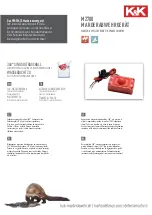
Chapter 4. Ladder Diagram (LD) Programming
GFK-2950C
February 2018
223
On Delay Stopwatch Timer
The retentive On-Delay Stopwatch Timer (ONDTR) increments while
it receives power flow and holds its value when power flow stops.
Time may be counted in the following increments:
■
Seconds
■
Tenths (0.1) of a second
■
Hundredths (0.01) of a second
■
Thousandths (0.001) of a second
Mnemonics:
ONDTR_SEC
ONDTR_TENTHS
ONDTR_HUNDS
ONDTR_THOUS
The range is 0 to +32,767 time units. The state of this timer is retentive on power failure; no
automatic initialization occurs at power-up.
When ONDTR first receives power flow, it starts accumulating time (Current Value (CV)). When the
CV equals or exceeds Preset Value (PV), output Q is energized, regardless of the state of the power
flow input.
As long as the timer continues to receive power flow, it continues accumulating until CV equals the
maximum value (+32,767 time units). Once the maximum value is reached, it is retained and Q
remains energized regardless of the state of the enable input.
When power flow to the timer stops, CV stops incrementing and is retained. Output Q, if energized,
will remain energized. When ONDTR receives power flow again, CV again increments, beginning at
the retained value.
When reset (R) receives power flow and PV is not equal to zero, CV is set back to zero and output Q
is de-energized.
Note:
If PV equals zero, the time is disabled and the reset is activated, and the output of the time
becomes high. Subsequent removal of the reset or activation of input will have no effect on
the timer output; the output of the time remains high.
ONDTR passes power flow to the right when CV is greater than or equal to PV. Since no automatic
initialization to the outgoing power flow state occurs at power-up, the power flow state is retentive
across power failure.
Notes:
▪
The best way to use an ONDTR function is to invoke it with a particular reference address exactly
one time each scan. Do not invoke an ONDTR with the same reference address more than once
per scan (inappropriate accumulation of time would result). When an ONDTR appears in a
program block, it will only accumulate time once per scan. Subsequent calls to that same
program block within the same scan will have no effect on its ONDTRs. Do not program an
ONDTR function with the same reference address in two different blocks. You should not
program a JUMPN around a timer function. Also, if you use recursion (that is, having a block call
itself either directly or indirectly), program the program block so that it invokes the timer before
it makes any recursive calls to itself.
▪
For information on using timers inside parameterized blocks, refer to
▪
An ONDTR expires (passes power flow to the right) the first scan that is enabled and not reset if
the previous scan time was greater than PV.
Summary of Contents for PACSystems RX7i
Page 357: ......
Page 466: ...Chapter 9 Diagnostics GFK 2950C February 2018 451...
















































